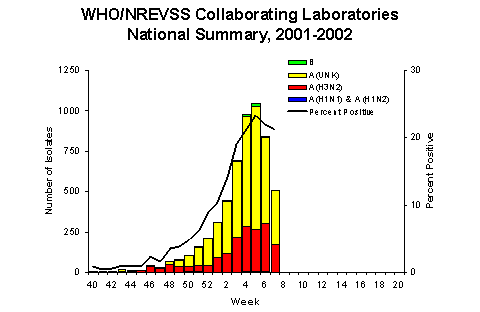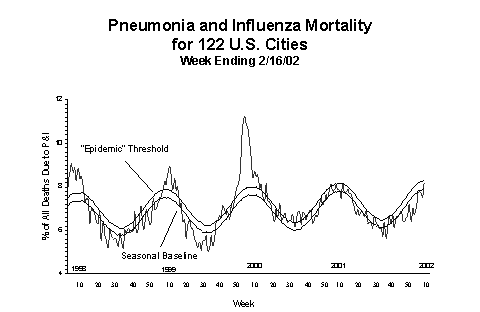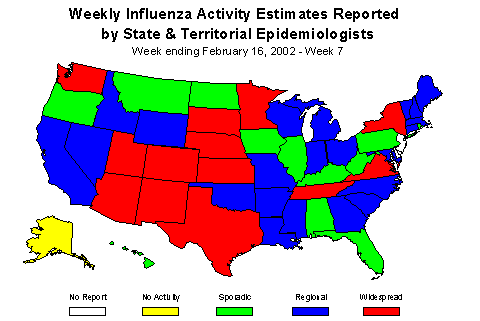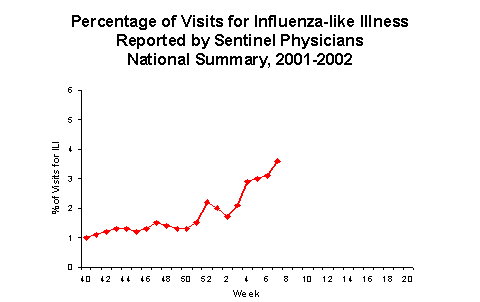Error processing SSI file
Error processing SSI file
Weekly Report: Influenza Summary Update
Week ending February 16, 2002-Week 7
The following information may be quoted:
Synopsis:
During week 7 (February 10-16, 2002)*, 507 (21.1%) of 2,398 respiratory specimens tested by World Health Organization (WHO) and National Respiratory Virus Surveillance System (NREVSS) laboratories were positive for influenza. The overall proportion of patient visits to sentinel physicians for influenza-like illness (ILI) was 3.6%, which is above the national baseline of 1.9%. The proportion of deaths attributed to pneumonia and influenza was 8.2%, which is below the epidemic threshold of 8.3% for week 7. Thirteen state and territorial health departments reported widespread influenza activity, 22 reported regional activity, 12 reported sporadic activity, and one reported no influenza activity **.
Laboratory Surveillance*:
During week 7, WHO and NREVSS laboratories reported 2,398 specimens tested for influenza viruses, of which 507 (21.1%) were positive. One hundred and seventy-four influenza A(H3N2) viruses, 328 unsubtyped influenza A viruses, and 5 influenza B viruses were identified. During the past 3 weeks (weeks 5-7), between 30% and 38% of the specimens tested for influenza in the New England, South Atlantic, and West South Central regions were positive. The percent of respiratory specimens testing positive for influenza in the Mid-Atlantic, East South Central, Mountain, West North Central, and East North Central regions ranged from 14% to 23%. Seven percentage of specimens tested for influenza in the Pacific region were positive.
Since September 30, WHO and NREVSS laboratories have tested a total of 47,974 specimens for influenza viruses and 5,574 (11.6%) were positive. Of the 5,574 isolates identified, 5,506 (99%) were influenza A viruses and 68 (1%) were influenza B viruses. One thousand seven hundred and fifty-six (32%) of the 5,506 influenza A viruses identified have been subtyped; 1,739 (99%) were H3 viruses and 17 (1%) were H1 viruses. Laboratory-confirmed influenza has been reported by all 50 states.

Antigenic Characterization:
CDC has antigenically characterized 239 influenza viruses collected from U.S. laboratories since October 1: 220 influenza A(H3N2) viruses, 4 influenza A H1 viruses, and 15 influenza B viruses. The influenza A (H3N2) and A H1 viruses were similar to the vaccine strains A/Panama/2007/99 (H3N2) and A/New Caledonia/ 20/99 (H1N1), respectively. One of the H1 viruses is an H1N2 virus from a patient specimen collected in Wisconsin in December. Two additional H1N2 viruses have been identified from patient specimens collected during July and September in Texas and Nevada, respectively.
Click here for more information about influenza A(H1N2) viruses
Influenza B viruses currently can be divided into 2 antigenically distinct lineages, B/Yamagata/16/88 and B/Victoria/2/87. Viruses of the B/Yamagata lineage have circulated widely since 1990. Viruses of the B/Victoria lineage had not been identified outside of Asia between 1991 and March 2001. Since March 2001, B/Victoria lineage viruses have been identified in Hawaii, Canada, China, Hong Kong, India, Italy, Japan, the Netherlands, Oman, the Philippines, and Thailand. CDC has antigenically characterized 15 influenza B viruses collected since October 1 from U.S. laboratories; 14 belonged to the B/Yamagata lineage and 1 belonged to the B/Victoria lineage. Of the 14 B/Yamagata lineage viruses, 6 were similar to the vaccine strain, B/Sichuan/379/99, and 8 showed somewhat reduced titers to ferret antisera produced against B/Sichuan/379/99. The B component of the current influenza vaccine belongs to the B/Yamagata lineage and is expected to provide lower levels of protection against viruses of the B/Victoria lineage. A final decision has not yet been made in the United States regarding the influenza B component of the 2002-03 vaccine.
Pneumonia and Influenza (P&I) Mortality Surveillance:
During week 7, the percentage of all deaths due to pneumonia and influenza as reported by the vital statistics offices of 122 U.S. cities was 8.2%. This percentage is below the epidemic threshold of 8.3% for week 7.

Influenza-like Illness Surveillance *:
During week 7, 3.6% of patient visits to U.S. sentinel physicians were due to ILI. This is above the national baseline of 1.9%. On a regional level, the percentage of visits for ILI ranged from 2.7% to 6.7%.*** Due to wide variability in regional level data, it is not possible to calculate region-specific baselines and it is not appropriate to apply the national baseline to regional level data.
Influenza Activity as Assessed by State and Territorial Epidemiologists**:
Influenza activity was reported as widespread in 13 states (Arizona, Colorado, Kansas, Minnesota, Nebraska, New Mexico, New York, South Dakota, Tennessee, Texas, Utah, Virginia, and Washington), and regional in 22 states (Arkansas, California, Connecticut, Georgia, Idaho, Indiana, Louisiana, Maine, Maryland, Massachusetts, Michigan, Mississippi, Missouri, Nevada, New Hampshire, North Carolina, Ohio, Oklahoma, South Carolina, Vermont, Wisconsin, and Wyoming). Twelve states, New York City, and Washington, DC reported sporadic activity, one state reported no influenza activity, and two states did not report.

* Reporting is incomplete for this week. Numbers may change as more reports are received.
** Influenza activity is defined as influenza-like illness and/or culture-confirmed influenza.
*** Surveillance Regions: New England (Connecticut, Maine, Massachusetts, New Hampshire, Vermont, Rhode Island); Mid-Atlantic (New Jersey, New York City, Pennsylvania, Upstate New York); East North Central (Illinois, Indiana, Michigan, Ohio, Wisconsin); West North Central (Iowa, Kansas, Minnesota, Missouri, Nebraska, North Dakota, South Dakota); South Atlantic (Delaware, Florida, Georgia, Maryland, North Carolina, South Carolina, Virginia, Washington, D.C., West Virginia); East South Central (Alabama, Kentucky, Mississippi, Tennessee); West South Central (Arkansas, Louisiana, Oklahoma, Texas); Mountain (Arizona, Colorado, Idaho, Montana, Nevada, New Mexico, Utah, Wyoming); Pacific (Alaska, California, Hawaii, Oregon, Washington)
Report prepared February 21, 2002
Error processing SSI file